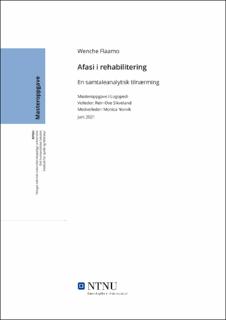| dc.contributor.advisor | Sikveland, Rein Ove | |
| dc.contributor.advisor | Norvik, Monica | |
| dc.contributor.author | Flaamo, Wenche | |
| dc.date.accessioned | 2021-09-28T17:28:37Z | |
| dc.date.available | 2021-09-28T17:28:37Z | |
| dc.date.issued | 2021 | |
| dc.identifier | no.ntnu:inspera:80372130:24169558 | |
| dc.identifier.uri | https://hdl.handle.net/11250/2784408 | |
| dc.description.abstract | Bakgrunn: Afasi er en språkvanske som oppstår etter skade eller sykdom i hjernens språksenter. Personer med afasi har de samme kognitive ressurser som tidligere, det er kun språket som rammes. Hjerneslag er en vanlig årsak, en regner med at rundt 25% av slagpasientene får afasi i en eller annen form. Evnen til å kommunisere er fundamental for oss mennesker, og gjennom samhandling med andre utvikler vi oss og finner oss til rette i samfunnet. God kommunikasjon danner også grunnlag for det som man innenfor helsepolitikken har lært å kjenne som pasientrettet pleie, med brukermedvirkning og aktiv deltakelse som sentrale, lovfestede prinsipper. Mål og innhold i rehabiliteringen skal ta utgangspunkt i pasientens ønsker og behov, og realiseres ved tverrfaglig samarbeid. For personer med afasi, oppleves det utfordrende å få tilgang til informasjon som omhandler behandling, og de savner å bli hørt når beslutninger skal tas. For de som er alvorlig rammet av afasi oppleves det ekstra utfordrende.
Behandlere som arbeider med personer med afasi opplever også frustrasjon over å ikke være i stand til å sette sine klienter i førersetet for egen rehabilitering, og med det, etterfølge lovgivingen. De har ønske om å hjelpe, men de har ikke de redskaper som trengs for å greie det.
Formål: Studien søker å finne samtalepraksis som støtter ulike typer deltakelse hos en person med afasi.
Metode: Informasjon ble samlet inn gjennom videoopptak av en person med afasi i samtale med tre av sine behandlere i treningssituasjon. Samtaleanalyse ble brukt i behandlingen av materialet.
Funn: Selv med svært begrenset ordforråd, finnes gode muligheter for effektiv kommunikasjon. Ved å bruke tilgjengelige ressurser og ved å være oppmerksom på de muligheter det gir i kommunikasjon, kan behandlere lære seg å legge til rette for selvstendige bidrag og medvirke til bedre muligheter for brukermedvirkning og aktiv deltakelse i rehabilitering.
Konklusjon: Med behandlere som ønsker å bidra til bedre kommunikasjon og som søker strategier og opplæring for å få det til, bør det være gode forutsetninger for å gjøre hverdagsliv og rehabilitering lettere for personer med afasi. Samtaleanalytisk forskning vil kunne bidra til å identifisere slike strategier, samt undersøke hvordan de kan benyttes i hverdagslig og profesjonell praksis. | |
| dc.description.abstract | Background: Aphasia is a language difficulty that occurs after damage or disease in the language center of the brain. Language is the only part affected in people with aphasia, they have the same cognitive resources as before. Stroke is a common cause of aphasia, with about 25% of stroke patients acquiring aphasia in one form or another. The ability to communicate is fundamental, and we develop and find our place in society through interaction with others. Good communication also makes up the basis for what we, through health policy, known as patient-centered care, with user participation and active participation as central statutory principles. Goals and content in the rehabilitation shall be based on the wishes and needs of the patient and realized through interdisciplinary cooperation. People with aphasia find it challenging to get access to information regarding therapy, and miss being heard in the decision-making process. People affected by serious aphasia find it even more challenging.
Therapists working with people with aphasia also experience frustration with not being able to put their clients in control over their own rehabilitation, and, with that follows legislation. They want to help, but lack the tools required to do it.
Purpose: The study seeks to identify conversation practice supporting different kinds of participation from a person with aphasia.
Method: Data were collected through video recordings of a person with aphasia in conversation with three of their therapists in a training situation. Conversation analysis was used to analyze the material.
Findings: Even with highly limited vocabulary there are good opportunities for efficient communication. Therapists can, through available resources and by being aware of the possibilities they give in the interaction, learn to facilitate independent contributions from the person with aphasia, and contribute to creating better opportunities active co-participation in the rehabilitation.
Conclusion: With therapists wanting to contribute to better communication, and seeking strategies and training to make it happen, the foundations is already there for making everyday-life and rehabilitation easier for people with aphasia. Conversation analytic research helps identify what those strategies look like and how they can be used in everyday and professional practice. | |
| dc.language | nob | |
| dc.publisher | NTNU | |
| dc.title | Afasi i rehabilitering
En samtaleanalytisk tilnærming | |
| dc.type | Master thesis | |
